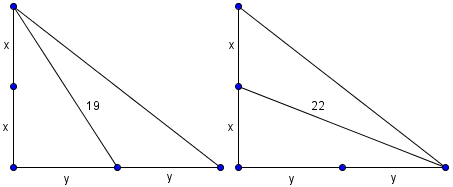Difference between revisions of "2002 AMC 12B Problems/Problem 20"
(→Solution 1) |
(→Video Solution by OmegaLearn) |
||
| (3 intermediate revisions by 2 users not shown) | |||
| Line 41: | Line 41: | ||
Then, we substitute: <math>XY=\sqrt{x^2+y^2}=\sqrt{676}=\boxed{26}.</math> | Then, we substitute: <math>XY=\sqrt{x^2+y^2}=\sqrt{676}=\boxed{26}.</math> | ||
| + | |||
| + | |||
| + | == Solution 3 (Solution 1 but shorter) == | ||
| + | Refer to the diagram in solution 1. <math>4x^2+y^2=361</math> and <math>4y^2+x^2=484</math>, so add them: <math>5x^2+5y^2=845</math> and divide by 5: <math>x^2+y^2=169</math> so <math>\dfrac{XY}{2}=\sqrt{169}=13</math> and so <math>XY=26</math>, or answer <math>B</math>. | ||
| + | |||
| + | == Solution 4 == | ||
| + | Use the diagram in solution 1. Get <math>4x^2+y^2=361</math> and <math>4y^2+x^2=484</math>, and multiply the second equation by 4 to get <math>4x^2+16y^2=1936</math> and then subtract the first from the second. Get <math>15y^2=1575</math> and <math>y^2=105</math>. Repeat for the other variable to get <math>15x^2=960</math> and <math>x^2=64</math>. Now XY is equal to the square root of four times these quantities, so <math>(105+64) \cdot 4=676</math>, and <math>XY=26</math> | ||
| + | |||
| + | |||
| + | == Video Solution by OmegaLearn == | ||
| + | https://youtu.be/BIyhEjVp0iM?t=174 | ||
| + | |||
| + | ~ pi_is_3.14 | ||
| + | |||
| + | == Video Solution == | ||
| + | https://www.youtube.com/watch?v=7wj6RupkO90 ~David | ||
== See also == | == See also == | ||
Latest revision as of 14:02, 17 August 2023
- The following problem is from both the 2002 AMC 12B #20 and 2002 AMC 10B #22, so both problems redirect to this page.
Contents
Problem
Let ![]() be a right-angled triangle with
be a right-angled triangle with ![]() . Let
. Let ![]() and
and ![]() be the midpoints of legs
be the midpoints of legs ![]() and
and ![]() , respectively. Given that
, respectively. Given that ![]() and
and ![]() , find
, find ![]() .
.
![]()
Solution 1
Let ![]() ,
, ![]() . By the Pythagorean Theorem on
. By the Pythagorean Theorem on ![]() respectively,
respectively,
![]()
Summing these gives ![]() .
.
By the Pythagorean Theorem again, we have
![]()
Alternatively, we could note that since we found ![]() , segment
, segment ![]() . Right triangles
. Right triangles ![]() and
and ![]() are similar by Leg-Leg with a ratio of
are similar by Leg-Leg with a ratio of ![]() , so
, so ![]()
Solution 2
Let ![]() and
and ![]() Then,
Then, ![]()
Since ![]() and
and ![]()
![]()
![]()
Adding these up:
![]()
![]()
![]()
![]()
Then, we substitute: ![]()
Solution 3 (Solution 1 but shorter)
Refer to the diagram in solution 1. ![]() and
and ![]() , so add them:
, so add them: ![]() and divide by 5:
and divide by 5: ![]() so
so ![]() and so
and so ![]() , or answer
, or answer ![]() .
.
Solution 4
Use the diagram in solution 1. Get ![]() and
and ![]() , and multiply the second equation by 4 to get
, and multiply the second equation by 4 to get ![]() and then subtract the first from the second. Get
and then subtract the first from the second. Get ![]() and
and ![]() . Repeat for the other variable to get
. Repeat for the other variable to get ![]() and
and ![]() . Now XY is equal to the square root of four times these quantities, so
. Now XY is equal to the square root of four times these quantities, so ![]() , and
, and ![]()
Video Solution by OmegaLearn
https://youtu.be/BIyhEjVp0iM?t=174
~ pi_is_3.14
Video Solution
https://www.youtube.com/watch?v=7wj6RupkO90 ~David
See also
| 2002 AMC 10B (Problems • Answer Key • Resources) | ||
| Preceded by Problem 21 |
Followed by Problem 23 | |
| 1 • 2 • 3 • 4 • 5 • 6 • 7 • 8 • 9 • 10 • 11 • 12 • 13 • 14 • 15 • 16 • 17 • 18 • 19 • 20 • 21 • 22 • 23 • 24 • 25 | ||
| All AMC 10 Problems and Solutions | ||
| 2002 AMC 12B (Problems • Answer Key • Resources) | |
| Preceded by Problem 19 |
Followed by Problem 21 |
| 1 • 2 • 3 • 4 • 5 • 6 • 7 • 8 • 9 • 10 • 11 • 12 • 13 • 14 • 15 • 16 • 17 • 18 • 19 • 20 • 21 • 22 • 23 • 24 • 25 | |
| All AMC 12 Problems and Solutions | |
The problems on this page are copyrighted by the Mathematical Association of America's American Mathematics Competitions. 










